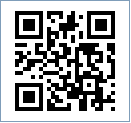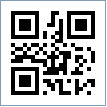QR Code (Quick Response Code)
Also known as Denso Barcode, QRCode, Quick Response Code, JIS X 0510, ISO/IEC18004
This Barcode Symbology is supported by the following Neodynamic products:- Barcode Professional SDK for .NET Projects
- Barcode Professional for Windows Forms
- BarcodePro Web API for Docker
- Barcode Professional for WPF
- Barcode Professional for XAML WinRT Windows Store
- Barcode Professional for ASP.NET (Web Forms, MVC Razor, AJAX)
- Barcode Professional for Silverlight LOB
- Barcode Professional for Reporting Services (CRI & DLL for SSRS (RDL))
- Barcode Professional for .NET STANDARD
- Barcode Professional for Blazor
- ThermalLabel SDK for .NET
- Barcode Professional for Windows Phone
- Barcode Professional for .NET Compact Framework
Overview
 QR Code is a kind of 2-D (two-dimensional) symbology developed by Denso Wave (a division of Denso Corporation at the time) and released in 1994 with the primary aim of being a symbol that is easily interpreted by scanner equipment.
QR Code is a kind of 2-D (two-dimensional) symbology developed by Denso Wave (a division of Denso Corporation at the time) and released in 1994 with the primary aim of being a symbol that is easily interpreted by scanner equipment.
QR Code is capable of handling all types of data, such as numeric and alphabetic characters, Kanji, Kana, Hiragana, symbols, binary, and control codes.
The symbol versions of QR Code range from Version 1 to Version 40. Each version has a different module configuration or number of modules (the module refers to the black and white dots that make up QR Code). "Module configuration" refers to the number of modules contained in a symbol, commencing with Version 1 (21 x 21 modules) up to Version 40 (177 x 177 modules). Each higher version number comprises 4 additional modules per side. Each QR Code symbol version has the maximum data capacity according to the amount of data, character type and error correction level. In other words, as the amount of data increases, more modules are required to comprise QR Code, resulting in larger QR Code symbols.
QR Code has error correction capability to restore data if the code is dirty or damaged. Four error correction levels are available for users to choose according to the operating environment. Raising this level improves error correction capability but also increases the amount of data QR Code size. To select error correction level, various factors such as the operating environment and QR Code size need to be considered. Level Q or H may be selected for factory environment where QR Code gets dirty, whereas Level L may be selected for clean environment with the large amount of data. Typically, Level M (15%) is most frequently selected. The QR Code error correction feature is implemented by adding a Reed-Solomon Code to the original data.
QR Code implementation in Barcode Professional supports FNC1 and Extended Channel Interpretation (ECI).

Sample of a QR Code barcode
How to create QR Code barcodes using Barcode Professional for
- Set the Symbology property to QRCode
- Set the QRCodeVersion property
- Set the QRCodeErrorCorrectionLevel property
- Set the QRCodeEncoding property
- Set the QRCodeMask property
- Setting up dimensions and quiet zones:
- Set the QRCodeModuleSize property (Value is expressed in Inches)
- Set the QuietZoneWidth property (Value is expressed in Inches)
- Set the TopMargin and BottomMargin properties (Values are expressed in Inches)
- Set the Code property with the value to encode
- If desired, you can use the tilde character "~" to specify special characters in the input data. To do that you must set the QRCodeProcessTilde property to True. Read more about how it works.
- Set the Symbology property to QRCode
- Set the QRCodeVersion property
- Set the QRCodeErrorCorrectionLevel property
- Set the QRCodeEncoding property
- Set the QRCodeMask property
- Setting up dimensions and quiet zones:
All values for barcode dimensions are expressed in INCHES by default. However, Barcode Professional supports other unit of measurement such as Millimeter, Centimeter, and Mils. For modifying the unit of measurement for barcoding, please set up the BarcodeUnit property as needed.
- Set the QRCodeModuleSize property (Value is expressed in Inches)
- Set the QuietZone property (Value is expressed in Inches)
- Set the TopMargin and BottomMargin properties (Values are expressed in Inches)
- Set the Code property with the value to encode
- If desired, you can use the tilde character "~" to specify special characters in the input data. To do that you must set the QRCodeProcessTilde property to True. Read more about how it works.
How QR Code tilde processing works
When working with QR Code tilde processing keep in mind the following rules:- ~1: is used to represent the FNC1 code
- ~7NNNNNN: is used to specify the Extended Channel Interpretation (ECI) and NNNNNN is a value between 000000 and 999999. Default is ECI 000003 which represents the ISO 8859-1 Latin Alphabet No. 1
- ~dNNN: is used to represent a byte value in decimal notation. NNN must be a numeric value ranging from 000 to 255
- ~hXX: is used to represent a byte value in hexadecimal notation. XX must be a hexadecimal value ranging from 00 to FF
- ~kXXXX: is used to represent a Kanji double-byte value in hexadecimal notation. XXXX must be a hexadecimal value of Shift JIS Kanji characters according to JIS X 0208:1997, Annex 1.
Example of QR Code barcode images
Code property = ABC 123456789 will produce the following barcode image:
